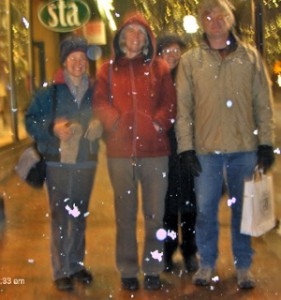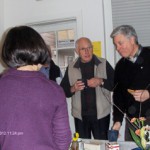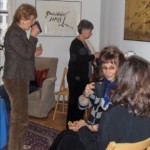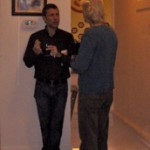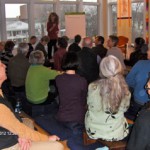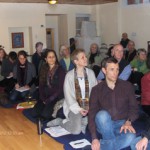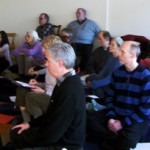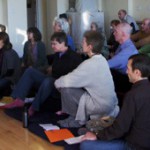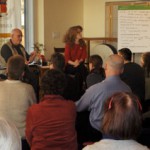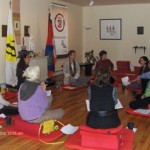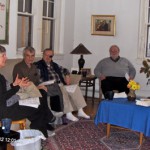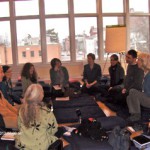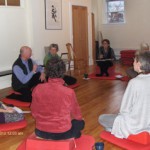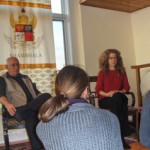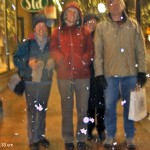Sunday
Community ArticlesFresh Baked Bread of Kindness
“… the appeal of Shambhala and our ability to benefit, influence, and inspire the world will come directly from our ability to manifest kindness, embody goodness, and create a genuine feeling of delightfulness….” ~ from the Letter of the Morning Sun by Sakyong Mipham Rinpoche
Led with ingenuity and insight by Shastri Bill Brauer and senior teacher Myra Woodruff, Director of Practice and Education in Burlington, and thirty-plus participants, this first-ever gathering of Vermont teachers, meditation instructors, assistant directors and Shambhala guides brought a wonderful mix of maturity, youthful playfulness, wit, humor and all-pervasive inspiration to the weekend’s contemplations and discussions.
On Friday evening two parts of the weekend’s foundation were laid. First, the definition of “teacher” was elucidated as it is found in Shambhala Governance documents. A teacher is: “anybody authorized to teach anybody anything about Shambhala.” Therefore, from the moment a Shambhala guide meets a new person at open house, teaching begins.
Secondly, the distinction between ‘being kind’ and being ‘kindness’ was highlighted. Being kind generally refers to an ‘action’ that is nice, or pleasant but could potentially be superficial whereas, ‘being kindness’ refers to manifesting the fullness of our being. The Shambhala tradition shows us the way in our lifetime to “be” kindness which is profound because it’s about being – not just about behavior. We have to “be” what the Shambhala terma teaches rather than just know it or talk about it.
The two-fold aspiration offered for the weekend was that, 1) we could deepen our appreciation of how, as teachers and instructors, we can become kindness, and 2) that we could deepen our connection with each other.
Saturday morning began with the focus on the role centers’ practice and education mandalas play in being kindness.
Ms. Woodruff glided across the front of the shrine room, helping us sort ourselves by interest into four break-out groups each with a focus on one part of the Way of Shambhala In Everyday Life (WOSIEL) curriculum: Contentment, Joy, Fearlessness or Wisdom. Specifically the question to be addressed was: How could the perspectives and practices contained in the WOSIEL curriculum bring us (and our students) into ‘being’ or embodying kindness?
- Shastri Bill Brauer at tea with participants
- Burlington Ho! Community Room
- in conversation
- Have to love Vermonters!
- Myra records discussion group reports
- St. Johnsbury group on the town Saturday night
At the end of the breakout group discussions, the enthusiasm was palpable. As each discussion group reported their understandings, they were compiled by Ms. Woodruff for all of us to see.
Following this harvesting of insights, the next question posed by Ms. Woodruff was: How do we bring these perspectives for cultivating kindness that we’ve identified in the WOSIEL classes into working with obstacles, negativity in ourselves and others and challenges in our centers?
Twenty-plus challenging situations emerged and became the basis for a passionate Saturday afternoon discussion. Too many, obviously, to report on, but ones that elicited particularly heartfelt discussions included the following two points.
How to inspire the profoundly dedicated tantrikas who have been to seminary and taught the Shambhala School of Buddhist Study classes for years and have a wealth of experience, to teach the WOSIEL classes.
One suggestion was that centers could hold versions of this weekend and invite a qualified WOSIEL teacher to introduce the everyday life curriculum as Ms. Woodruff had done for us.
Another suggestion was that since the WOS manuals for Meditation in Everyday Life and Contentment in Everyday life are not restricted, a WOSIEL teacher could introduce teachers who express interest to these two manuals so they could see for themselves the richness of the curriculum.
How can centers balance being a community with not having the curriculum requirements overwhelm teachers and students, i.e. how to have the appropriate agenda for resources at hand and avoid ‘burn-out’.
This conversation covered the gamut from stretching out the time in which a student can complete the entire Way of Shambhala I curriculum (which includes the first five Shambhala Training levels) to offering more Gateway Programs which offer “a bottomless pit of opportunities” to infuse any subject with the Shambhala view. What also came up was understanding that in some situations quality could increase by offering less, and that developing a system of volunteerism that balances centers’ needs with an individuals inspiration could change the dynamics. Other ideas included trying different program formats, using alternate locations from the center to introduce meditation, and finally – celebrating. In this discussion, the importance of having someone take the Health and Well Being seat in their center was emphasized.
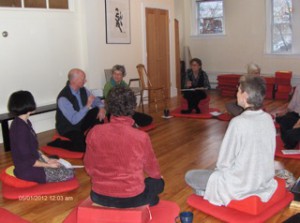 In the tradition of the Karme Choling Governance Council gathering we paused in the middle of the afternoon to rouse Windhorse in formal and informal ways. One such way is about telling jokes. One participant offered this one: Do you know where a snow man keeps his money? (**for the punch line, see the end of the article!)
In the tradition of the Karme Choling Governance Council gathering we paused in the middle of the afternoon to rouse Windhorse in formal and informal ways. One such way is about telling jokes. One participant offered this one: Do you know where a snow man keeps his money? (**for the punch line, see the end of the article!)
In the spirit of celebration our gracious Burlington hosts offered a rich, ratna cocktail party at 5:00pm.
Sunday morning began with Shastri Brauer leading a training exercise on being goodness with speech. He reminded us about the importance and challenge of manifesting kindness each time we open our mouth. The exercise mixed contemplation and raising windhorse. Each of the four individual lines of the Basic Goodness Proclamation was said slowly, contemplated, and then windhorse was raised (in whatever way participants knew) until all four lines had been contemplated and windhorse was raised four times.
Afterwards there were small group discussions about what potential effect this exercise could have on the path to becoming kindness. One senior student quipped: “It gave me a new appreciation for the short RL.” “No,” another older student retorted, “you mean URL!” (RL = Raising Lungta; URL = You Raising Lungta). In the midst of the humor there was genuine appreciation for this exercise.
As a way to bring kind speech into action and the weekend to fruition, Ms. Woodruff spoke about working with bringing kindness into tension and unknowing – particularly how to have difficult conversations around negativity and conflict. Using the format introduced at the Governance Gathering at Karme Choling, she explained the elements involved in having difficult conversations and then demonstrated with a participant a difficult conversation that might be necessary in a Shambhala Center.
As the program ended it was clear that the two-fold aspiration for the weekend had come to fruition: 1) Our appreciation of how, as teachers and instructors, we can become kindness-through a) working with the perspectives and practices of the Way of Shambhala In Everyday Life curriculum, b) applying ingenuity, kindness, and pro-activism to the issues arising in our centers, and c) through being conscious of our aspiration and our speech and the tools we have to raise kindness on the spot.
2) We had deepened our connections to each other. Common challenges, solutions and inspirations were shared often in informal conversation during the abundant teas. As the Health and Well Being director of Burlington said, the synergy of gathering with like-hearts having like-aspirations cannot be underestimated!
** Snow banks

